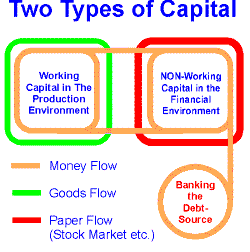|
Lesson One
Irving Fisher's Incomplete Formula.
When Irving Fisher in 1911 defined his famous Fisherian Equation in his publication "The Purchasing Power of Money.", he did not know that millions of people, bankers, economists, politicians would follow his line of thinking, without ever asking the question:
"Is it that simple? Is there nothing more to the velocity of money?"
 It is certain that when Irving Fisher wrote his book, the economy was reasonably uncomplicated and the formula worked reasonably well. However, especially in the United States were already signals of the development of two totally different economies, but the structures of those developments were not explicit visible. The only indication that something developed out of line was the formation of powerful banking interests and the birth of some extremely wealthy families. However, everyone recognized those developments as a normal product of an expansive new economy and not It is certain that when Irving Fisher wrote his book, the economy was reasonably uncomplicated and the formula worked reasonably well. However, especially in the United States were already signals of the development of two totally different economies, but the structures of those developments were not explicit visible. The only indication that something developed out of line was the formation of powerful banking interests and the birth of some extremely wealthy families. However, everyone recognized those developments as a normal product of an expansive new economy and not
the result of two totally different economies of which each created a totally different type of wealth. Production wealth consisting of high value dollars and fake wealth consisting of dollars with the same nominal value, but with a very low real value. Nobody could see which dollars had a high value and which dollars had a low value.
Of course, there were signals that something was developing contrary to the interests of the whole population. The most outspoken observer of those developments was the Democratic President Thomas Jefferson. There are several remarks and statements of Thomas Jefferson that contained a warning for the future.
There is little doubt that those warning became all remarkably true. In spite of the words spoken by politicians, the number of homeless people is still on the rise and Jefferson's statement about the banks and corporations is precisely on the mark. Peculiar is also that the first President of the United States John Adams came already to the conclusion that
something was wrong with our knowledge about our economic tools
An interesting question becomes now:
"Why has nothing changed during more than
two hundred years? Why are we still as dumb about real and basic economic
issues as two hundred and more years ago?
I can imagine that a large number of colleagues don't agree with my question. They must have become certain that we have an immense knowledge about the development of the economy. They are probably not aware that we have only become better mathematicians applying more sophisticated
formulas on the wrong economic axioms.
Fact is that after the second world-war the economic world became more and more complicated and nobody ever asked the question could it be possible that we have to review Irving Fisher's formula so that it will work better. After reading Fisher's book, I am convinced that when this economist had been able to look into the economic complexities of today, he would have recognized where his formulas would stop to work. He would immediately have made the small but essential correction that would have protected the post war economy against economic disaster after disaster.
The reality is that Irving was not among us and everyone in the economic arena thought that he had delivered the eternal wisdom. However, he had not. That was not Irving Fisher's fault, but simply the nearly unbelievable immature way the economic profession has treated the scientific approach of probably the most important science that ever existed. The science that defines our economic well being. The science that will either close the door or open the door to general prosperity and consequently to the ability to develop proper funding for the development of any other science.
Without the need to go into an elaborate explanation of Irving Fisher's
work we can easily write down his formula in the most elementary form to
show what went wrong. Fisher concluded that
|
The quantity of Money x
The Velocity of Money =
Purchasing Power of Money
|
Thus, it is quite easy to find out what has to be done when one of those values changes. This formula tells that when, i.e., the Quantity of Money decreases with 50% we have to double the velocity to get the same results. Thus
|
(The quantity of Money
/ 2) x
(2 x The Velocity
of Money) =
The same Purchasing Power of Money.
|
However, Fisher applied this formula on the wrong element. He saw only one type of money. In 1911 and later in his life he did not have the ability to see that the economy consists of three totally different types of capital. Fisherian's equation has only value when it is applied to two specific types of CAPITAL.
|